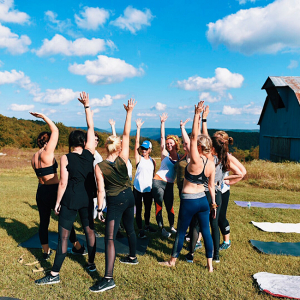Workplace Health: In This Together

Arkansas businesses large and small are starting to take the mental and physical health of employees seriously by offering some seriously cool benefits.
Escalating health care costs and the quest to land and keep employees are leading companies to incorporate workplace wellness programs targeting areas of employees’ personal health habits to drive down costs while promoting workers’ quality of life.
“When I have long-term employees, it’s just more profitable, so I try to provide for them and encourage them in ways that get them to stick around,” said Douglas Braswell, president of Braswell & Son of Little Rock. “If you demonstrate that you care about people more than just what they do for you on the job, they will want to stay.”

A Healthy Valuation
According to a 2013 study by the Rand Corp., roughly half of U.S. companies offer some kind of wellness benefit for employees apart from health insurance. These benefits can be narrow in scope, such as picking up the tab on a gym membership, or they can be incredibly comprehensive, including on-site, on-demand medical and fitness professionals.
Wellness programs definitely cost money, but weighed against direct and ancillary costs of illness and injury, such as lost work time and lower productivity, companies increasingly see these programs less as cost centers and more as an investment.
“Our goal in the wellness programs that we offer is to improve lifestyle choices,” said Richard Cooper, vice president of human resources for Arkansas Blue Cross & Blue Shield. “Not all of these things are tied to the health insurance we provide employees. We encourage them just in regard to their health to get preventative services—colonoscopies, mammograms. Going for your annual checkup—we think that’s very important.
“In addition, we have client companies that are interested in wellness, and we certainly encourage them to get into that and offer wellness activities for their employees.”
(See how you too can Take the Blue & You Fitness Challenge!)
For The Love Of Employee
In Arkansas, few programs are as robust as Conway-based Nabholz Construction’s, which boasts its own fully staffed medical clinic for employees and spouses, free of charge. Cash rewards are tied to positive health screenings; for those who fall short, the company offers one-day paid retreats to help re-educate motivated employees to make changes in diet, activity level or other habits. The list goes on.
Jayme Mayo, 2015 recipient of Arkansas Business’ Healthcare Hero Award, said what makes any wellness program good isn’t what’s offered, but how well it resonates with employees. When she came on board nine years ago, the company’s program was in shambles, due to outsourced administrative functions with no one-on-one, in-person attention.
“What we learned early on was webinars and phone counseling really wasn’t going to change behavior,” she said. “My guys want to shake your hand, hug your neck; they want to look you in the eye and have a conversation. It was about trust and relationship and establishing rapport.
“So, we’re on the job site and they see us in the office and I don’t have an agenda when I go visit them. ‘Hey, how’s your mama doing? How’s your son’s soccer team doing?’ It’s very conversational, and that’s part of the relationship. I’m concerned about cholesterol, but I’m more concerned about you as a person and your quality of life and your family’s quality of life.”
Companies that connect with employees on a personal level are not only more successful in their program take rate, they tend to redefine wellness in a very personal context, giving them the freedom to try new things.
“One benefit we’ve added in the last three years is a corporate chaplain,” Braswell said. “At first, I didn’t think my staff would care for it that much, but I thought I’d try it out and see. I’m extremely surprised at how much he gets used. He just comes around and says hello to folks and gets to know them a little bit. He also visits people in the hospital and does marriage counseling and other stuff.”
Motivation & Accountability
Gregg Curtis, owner of The Good Earth Garden Center, employs similarly intuitive leadership, believing the most impactful wellness offerings are driven from the bottom up. He keeps an open door and an open mind to employee suggestions, Zumba classes at the nursery being one of the more legendary.
“I don’t push corporate extracurricular activities just because we work so much and they work hard and I would hate to have somebody get injured at a company function,” he said. “I really just try to build into their self-esteem first of all, let them know how important they are. And then if you’re going to do other things on top of that, OK, let’s just kind of see what you want to do.
“If someone says, ‘I want to lose weight,’ great. I’m going to sponsor you for the first six months at the gym. Or, ‘I want to quit smoking,’ great. We’ll help you buy some patches and then once you quit for six months, you’ll get a $500 bonus. If you quit for a year, you’ll get another something.”
One idea for which Curtis does take credit is the new life coach on premises once a week for group team building and individual fulfillment coaching. Like Braswell, Curtis saw initial reluctance, but having personally benefited from such resources in the past, gave it a go anyway.
“The first week it was kinda weird like, ‘Hey I don’t want to do that,’ and then a couple guys came out and said, ‘Oh my gosh, that’s incredible,’” he said. “The next week we get a few more. The next week, we have to make a list because so many people want to do it. It’s just a matter of them buying into it and seeing the benefit.”

Start Something Big (Or Small)
Shannon Ledbetter, wellness coordinator for CHI St. Vincent Hot Springs, said a program can start with just one simple activity which, promoted correctly and easily accommodated into hectic schedules, can have far more impact on employees’ wellbeing as offering twice as many options.
“You can start small; I literally went online and keyed in ‘corporate walking clubs,’” she said. “We made changes in the cafeteria. You can have department meetings with a couple of people and discuss ways to be healthier. It can start with little things.”
Ledbetter said relatively simple, low-time-commitment activities like her monthly walking club, which currently boasts 215 participants, or the annual biggest loser weight-loss event, are particularly appealing when people constantly hear about them or work alongside peers who are participating.
“I speak at hospital orientations so right when people are new they hear about all of these programs,” she said. “I have posters and I have a big board outside my office. We have a blog now and I have email for the walking club and use it to keep them motivated.”
Savings aside, wellness programs provide a boost in morale not only for employees, but for the people and departments that put them on and see the positive results.
“We really feel terrific about it,” Cooper said. “We’ve had a lot of really good success stories [at Blue Cross & Blue Shield] where an employee has lost weight or taken our advice and had preventative medical services that discovered something in the early stage that they were able to manage and not have a serious health problem. It’s a good story that makes our employees feel good too — we love it when that happens.”








